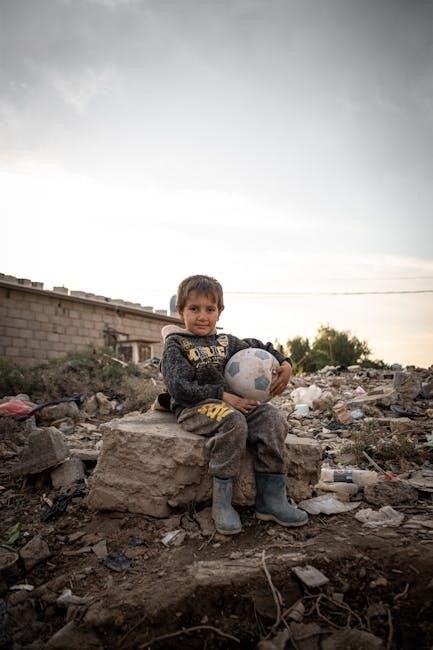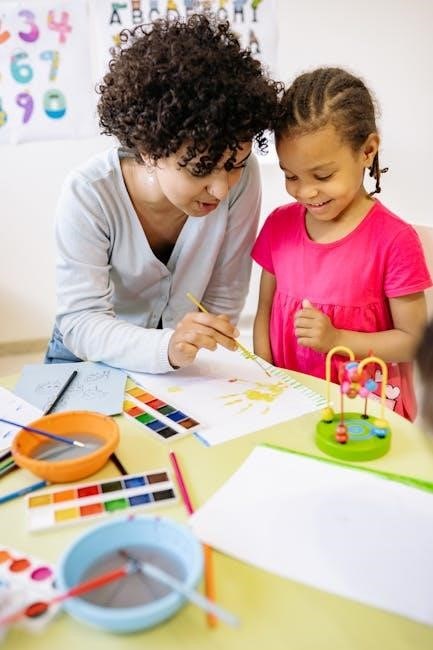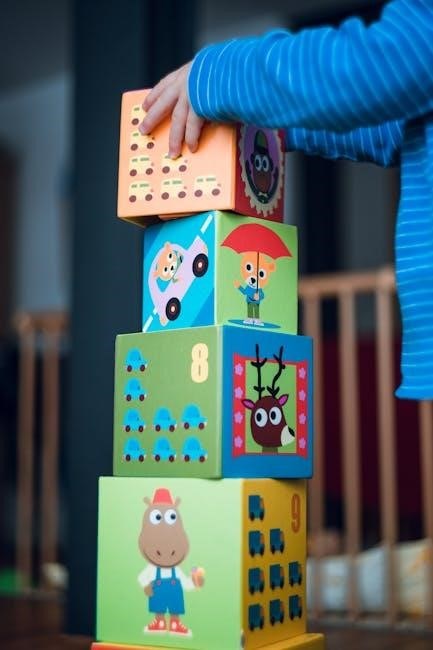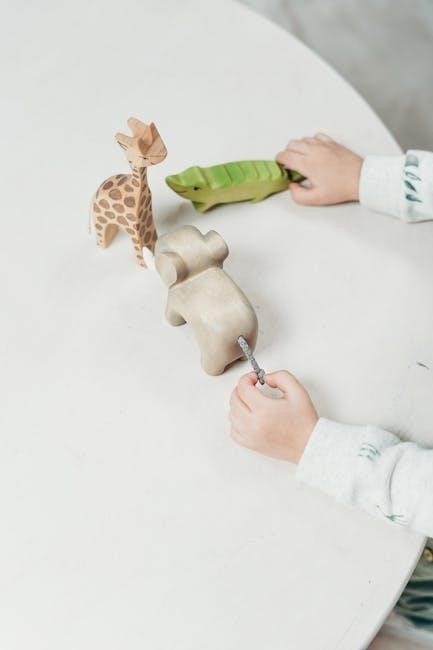Play is a cornerstone of child development, fostering skills like sharing, teamwork, and problem-solving. Understanding the stages of play development chart helps parents and educators support children’s growth.
This guide outlines how play evolves from exploratory behaviors to complex social interactions, providing a framework to monitor progress and encourage lifelong learning through play.
Understanding the Importance of Play in Child Development
Play is a vital component of child development, serving as a foundation for cognitive, social, emotional, and physical growth. It enables children to explore their environment, develop problem-solving skills, and build relationships. Through play, children learn to communicate, cooperate, and understand boundaries, laying the groundwork for lifelong learning and social interactions. Recognizing the stages of play development helps parents and educators create supportive environments that nurture these skills. By understanding how play evolves, caregivers can provide age-appropriate activities that foster independence, creativity, and teamwork, ensuring children reach their full potential. Play is not just entertainment; it is a critical tool for holistic development.
Overview of the Stages of Play Development Chart
The stages of play development chart provides a structured framework to understand how children progress in their play behaviors. It outlines six distinct stages, from unoccupied behavior to cooperative play, each with specific characteristics. This chart is a valuable tool for parents, educators, and caregivers to monitor a child’s developmental milestones. By identifying the stage of play, adults can offer appropriate support and resources to foster growth. The chart also highlights the transition from solitary activities to social interactions, emphasizing the importance of play in developing skills like communication, teamwork, and problem-solving. It serves as a guide to create enriching environments that promote healthy development and lifelong learning through play.

Theoretical Foundations of Play Development
Theoretical foundations of play development are rooted in Parten’s 1923 stages, highlighting how play progresses from solitary to cooperative activities, fostering social, cognitive, and emotional growth in children.
Parten’s Stages of Social Play (1923)
Mildred Parten’s groundbreaking work introduced a framework for understanding child play, categorizing it into six distinct stages: unoccupied, solitary, onlooker, parallel, associative, and cooperative play. These stages illustrate how children progress from independent activities to complex social interactions. Parten’s theory emphasizes the developmental significance of play, highlighting its role in fostering social, cognitive, and emotional growth. Her work remains foundational in early childhood education, providing insights into how play evolves and how it supports children’s ability to interact and collaborate with others. By recognizing these stages, educators and caregivers can better tailor environments and activities to meet children’s developmental needs, encouraging healthy growth and social competence.
Key Theorists and Their Contributions to Play Development
Several theorists have shaped our understanding of play development, complementing Parten’s framework. Lev Vygotsky emphasized play as a tool for cognitive development, while Jean Piaget linked play to stages of cognitive growth. Erik Erikson highlighted play’s role in fostering identity and social skills. Friedrich Froebel, founder of the kindergarten, stressed the importance of imaginative play in early learning. These theorists collectively underscore the significance of play in holistic child development, providing a rich foundation for understanding how children learn and grow through play. Their contributions remain essential for educators and caregivers aiming to create nurturing environments that support children’s natural inclination to explore and learn.
Stage 1: Unoccupied Behavior
Stage 1 involves children engaging in random movements or observing their environment without focused play. Parten identified this as the starting point of play development, emphasizing exploration and early motor skill discovery.
Characteristics of Unoccupied Play
Unoccupied play is the first stage of play development, characterized by random movements, exploration, and a lack of focused engagement with toys or others. Children in this stage may appear disinterested or disconnected, as they are primarily observing their environment. This stage is crucial for sensory exploration and early motor skill development. It often occurs in infants and young toddlers, laying the groundwork for more structured play in later stages. Unoccupied play is not about interaction but about individual discovery, making it a foundational step in the progression of play development.
Developmental Milestones in Unoccupied Behavior
During unoccupied play, children exhibit random movements and sensory exploration, crucial for early motor skill and cognitive development. Infants and toddlers in this stage begin to discover their environment through touch, sight, and sound. This phase lays the foundation for future play stages, as it enhances curiosity and basic coordination. Caregivers can support this milestone by providing a safe, stimulating environment that encourages exploration. Over time, children transition from unoccupied behavior to more focused and interactive forms of play, marking significant progress in their developmental journey. This stage is essential for building the skills needed for advanced social and cognitive growth.
Activities That Promote Unoccupied Play
Unoccupied play thrives in sensory-rich environments where children can freely explore. Activities like sensory bins filled with rice or sand, art projects with open-ended materials, and music exploration encourage independent discovery. Providing a variety of textures, colors, and sounds stimulates curiosity and creativity. Caregivers can support this by minimizing distractions, allowing children to engage at their own pace. Simple toys like blocks, stacking cups, or soft fabrics also foster unoccupied play, helping children develop motor skills and imagination. These activities lay the groundwork for more structured play stages, promoting cognitive and emotional growth through self-directed learning and exploration.

Stage 2: Solitary Play
Solitary play is a natural phase where children engage independently, fostering self-reliance and concentration. It supports cognitive and motor development as they explore and learn alone.

Features of Solitary Play in Children
Solitary play is a natural phase where children engage independently, focusing on their own interests and activities. This stage fosters self-reliance, creativity, and concentration, as children explore and learn without direct interaction with others. It is characterized by independence, with the child often immersed in their own world, whether building, drawing, or imagining. Solitary play supports cognitive development by encouraging problem-solving and critical thinking. Motor skills also improve as children practice tasks like puzzles or crafts. While they may not seek social interaction, having a quiet, safe environment is crucial. Adults should remain nearby to offer guidance while respecting the child’s need for autonomy. This stage is vital for building confidence and self-expression.
Cognitive and Motor Skill Development in Solitary Play
Solitary play significantly enhances both cognitive and motor skills in children. It allows them to practice problem-solving and critical thinking independently, fostering creativity and self-directed learning. Motor skills improve as children engage in activities like puzzles, drawing, or building, which refine hand-eye coordination and dexterity. This stage also promotes concentration and focus, essential for academic and personal growth. By exploring their environment and manipulating objects, children develop a deeper understanding of cause-and-effect relationships. Solitary play provides a foundation for future social interactions by building confidence and self-reliance. A quiet, safe space with age-appropriate tools encourages this development, helping children master skills at their own pace.
Encouraging Independent Play in Children
Encouraging independent play fosters self-reliance, creativity, and problem-solving skills in children. Provide a safe, quiet space with age-appropriate toys and materials to spark curiosity. Rotate toys regularly to maintain interest and prevent boredom. Activities like puzzles, building blocks, and art supplies are ideal for solitary play. Create a sensory-rich environment to explore, such as texture bins or stacking toys. Encourage children to take ownership of their play by allowing them to make choices. Avoid over-interference; instead, offer support when needed. This helps build confidence and independence. By promoting independent play, you nurture a strong foundation for cognitive and motor skill development, preparing children for future social and academic challenges.

Stage 3: Onlooker Play
Onlooker play marks the transition from solitary to social interaction, where children observe peers but do not join in. This stage fosters social awareness and curiosity.
Transition from Solitary to Onlooker Play
The shift from solitary to onlooker play typically occurs as children grow older and become more curious about their peers. Around 2-3 years old, they begin to show interest in others’ activities without actively participating. This transition is driven by increasing social awareness and a desire to learn from others. Parents and educators can encourage this shift by creating opportunities for observation, such as group settings, while ensuring children feel safe and supported. This stage is crucial for developing social skills and preparing for more interactive forms of play. Understanding this transition helps caregivers guide children toward meaningful social engagement.
Social and Observational Skills in Onlooker Play
During onlooker play, children develop essential social and observational skills by watching others engage in activities. This stage fosters curiosity and an understanding of social cues, as children learn by observing their peers. They begin to recognize patterns in behavior and interactions, laying the groundwork for future social engagement. Caregivers can support this development by providing opportunities for observation, such as group settings, while ensuring children feel secure. This stage is vital for building the confidence and interest needed for more active participation in play. By refining these skills, children prepare for the next stages of social interaction and collaboration.

Strategies to Foster Onlooker Play
Fostering onlooker play involves creating environments that encourage observation and curiosity. Provide opportunities for children to watch others play, such as in group settings, while ensuring they feel secure. Create a sensory-rich environment with diverse toys and activities to capture their interest. Encourage quiet observation by minimizing distractions, allowing children to focus on others’ actions. Offer open-ended materials that invite exploration and imitation. Caregivers can model behaviors and interactions, giving children a blueprint for future play. By supporting this stage, adults help children build confidence and develop the skills needed for more active social engagement. Patience and understanding are key to nurturing this transitional phase.

Stage 4: Parallel Play
Parallel play involves children engaging in similar activities alongside others without direct interaction. It fosters social awareness and lays the groundwork for future cooperative play.
Defining Parallel Play and Its Significance
Parallel play occurs when children engage in similar activities alongside others, often using the same toys or materials, but without direct interaction. This stage is crucial for developing social awareness and understanding group dynamics. It allows children to observe and learn from peers while maintaining independence. Parallel play helps build foundational skills for cooperation and communication, as children begin to recognize shared interests and boundaries. This phase is a natural progression from solitary play and paves the way for more interactive forms of play, such as associative and cooperative play. Recognizing parallel play’s significance helps caregivers and educators support children’s gradual integration into social environments.
Development of Social Awareness in Parallel Play
Parallel play fosters social awareness as children observe and imitate peers, learning boundaries and shared interests. This stage transitions from solitary play, encouraging children to engage in similar activities nearby, promoting a sense of community. Through observation, they develop an understanding of social dynamics and cooperation. Parallel play helps children recognize and respect personal space while building curiosity about others’ actions. This phase lays the groundwork for more interactive play, enhancing communication and teamwork skills. By participating in parallel activities, children gradually develop the ability to collaborate, preparing them for associative and cooperative play. This stage is vital for nurturing social-emotional growth and fostering a sense of belonging in group settings.
Activities That Enhance Parallel Play
Engaging in parallel play activities helps children develop social awareness and cooperation skills. Provide similar toys or materials, such as building blocks, coloring tools, or puzzles, to encourage side-by-side engagement. Create a sensory-rich environment with playdough, sand, or water tables, allowing children to explore independently while observing others. Group art projects, like collaborative murals, also foster parallel interaction. Offer open-ended toys that invite imitation, such as pretend play items like kitchen sets or doctor kits. Quiet, focused activities like sorting games or matching exercises can also enhance parallel play. These experiences help children gradually transition to more interactive forms of play while building their confidence and social curiosity.
Stage 5: Associative Play
Associative play involves children sharing materials and cooperating, beginning to communicate effectively while building on earlier stages to prepare for more complex social interactive play.
Characteristics of Associative Play
Associative play is marked by children sharing materials and engaging in cooperative activities, with a focus on communication and collaboration. At this stage, children begin to interact more directly, sharing goals and starting to take on roles. They show an emerging ability to work together, though their play may still lack a clear structure or shared purpose. This stage builds on earlier forms of play, fostering social bonds and laying the groundwork for more complex interactions. The emphasis is on mutual engagement, with children learning to balance their own interests with those of others, preparing them for the next stage of cooperative play.
Building Cooperation and Communication Skills
Associative play fosters cooperation and communication as children learn to share ideas and materials. This stage encourages mutual respect and teamwork, laying the groundwork for advanced social interactions. Children begin to understand the value of collaboration, developing essential life skills like negotiation and empathy. Through shared activities, they practice active listening and verbal expression, enhancing their ability to convey thoughts and needs. Adults can support this by modeling positive interactions and providing opportunities for group play. Encouraging turn-taking and shared goals helps refine these skills, preparing children for more complex cooperative play. This stage is crucial for building a strong foundation in social and emotional development.
Guiding Children Through Associative Play
Guiding children through associative play involves creating opportunities for shared activities and encouraging collaboration. Adults can facilitate this by modeling positive interactions and providing resources that promote group engagement. Encourage children to take turns, share materials, and work toward common goals. A sensory-rich environment can spark curiosity and foster mutual interest in play. Offer gentle guidance while allowing children to explore and learn independently. This stage is critical for building confidence and social competence. By supporting associative play, adults help children develop the skills needed for more complex cooperative interactions. This guidance ensures a smooth transition to the next stage of play development, fostering a strong foundation for social and emotional growth.
Stage 6: Cooperative Play
Cooperative play involves structured activities with rules, fostering advanced social and emotional development through teamwork and collaboration, and preparing children for complex social interactions and mutual respect.
Features of Cooperative Play
Cooperative play is the most advanced stage, characterized by structured activities with clear rules and shared goals. Children engage in complex social interactions, demonstrating teamwork, mutual respect, and empathy.
This stage fosters advanced communication, problem-solving, and decision-making skills. It involves collaborative efforts, such as role-playing or organized games, where children work together toward a common objective.
Cooperative play promotes emotional intelligence, as children learn to negotiate, compromise, and understand others’ perspectives. It is a critical milestone, preparing them for future social and academic challenges.
Advanced Social and Emotional Development
Cooperative play fosters advanced social and emotional development, enabling children to navigate complex interactions with empathy and understanding. This stage enhances skills like conflict resolution, negotiation, and mutual respect.
Children develop a stronger sense of self-awareness and emotional regulation, learning to balance their needs with those of others. Cooperative play also encourages shared responsibility and accountability, preparing children for real-world social dynamics.
A supportive environment, free from distractions, allows children to focus on these interactions, fostering deeper connections and emotional intelligence. This stage is crucial for building lifelong social skills and emotional resilience.
Encouraging Teamwork and Collaboration
Encouraging teamwork and collaboration is essential for fostering social skills in children. Cooperative play activities, such as group games or puzzles, promote shared goals and mutual respect.
Adults can facilitate this by modeling positive interactions and providing opportunities for children to work together. Structured activities that require collaboration help children develop problem-solving skills and learn to value others’ contributions.
Creating a supportive environment where children feel safe to share ideas and take turns strengthens their ability to collaborate. This stage is vital for building strong social bonds and preparing children for future teamwork experiences.
Practical Applications of the Play Development Chart
The chart provides a roadmap for parents and educators to support children’s development. It helps identify appropriate activities and environments for each stage, ensuring tailored support.
Using the Chart for Parents and Caregivers

The chart is an invaluable tool for parents and caregivers, offering insights into a child’s developmental milestones through play. It outlines activities and communication characteristics at each stage, from exploratory play in infants to role-playing and rule-based games in toddlers. By understanding these stages, caregivers can create sensory-rich environments and provide appropriate toys to foster growth. The chart also emphasizes the importance of quiet, focused playtime, free from distractions like noisy machines, to enhance a child’s ability to engage and learn. This guide is perfect for monitoring progress and providing tailored support, ensuring children build a strong foundation for lifelong learning.
Integrating the Chart into Educational Settings
Educators can effectively integrate the chart into their teaching practices to enhance children’s developmental outcomes. By understanding the stages of play, teachers can design activities that align with each child’s developmental level, fostering a supportive learning environment. The chart serves as a valuable resource for assessing progress and identifying areas where additional support may be needed. It encourages the creation of sensory-rich classrooms and the provision of age-appropriate toys to stimulate growth. Educators can also use the chart to plan lessons that promote social interaction, problem-solving, and communication skills. This tool not only aids in monitoring development but also helps educators tailor their approaches to meet the unique needs of each child, ensuring a strong foundation for future learning and social success.
Monitoring Progress and Supporting Development
Monitoring a child’s progress through the stages of play development chart allows caregivers to identify milestones and provide targeted support. By observing play behaviors, adults can assess social, cognitive, and motor skill development. The chart serves as a guide to track growth over time, ensuring children meet expected benchmarks. Caregivers can use this tool to recognize when a child may need additional support or enrichment. Creating a quiet, sensory-rich environment and engaging in activities that encourage exploration and interaction are effective ways to foster development. Regularly reviewing the chart helps caregivers adapt their strategies, ensuring each child receives the support needed to thrive and progress at their own pace.

Conclusion

Understanding the stages of play development empowers caregivers to support children’s growth effectively, fostering essential life skills, creativity, and promoting lifelong learning through structured play activities.
Summarizing the Stages of Play Development
The stages of play development, as outlined in the chart, progress from unoccupied behavior to cooperative play, reflecting children’s growing social, cognitive, and motor skills. Each stage builds on the previous one, fostering essential abilities like problem-solving, communication, and teamwork. Understanding these stages helps parents and educators create environments that nurture growth. The chart provides a clear roadmap, highlighting milestones and activities to support development. By recognizing these stages, caregivers can offer tailored support, ensuring children thrive and develop a strong foundation for lifelong learning. The free PDF chart serves as a valuable resource, guiding adults to encourage play that aligns with each child’s developmental needs.
Encouraging Lifelong Learning Through Play
Play is a powerful tool for fostering lifelong learning, as it nurtures curiosity, creativity, and critical thinking. By understanding the stages of play development, caregivers can create environments that encourage children to explore, experiment, and grow. The stages of play development chart provides a roadmap for supporting children as they progress from solitary activities to complex social interactions. Encouraging play helps children develop resilience, adaptability, and a love for learning that extends beyond childhood. Parents and educators can use the chart to identify milestones and provide activities that align with each stage, ensuring children build a strong foundation for future success. Play is not just fun—it’s a pathway to lifelong learning and personal growth.
